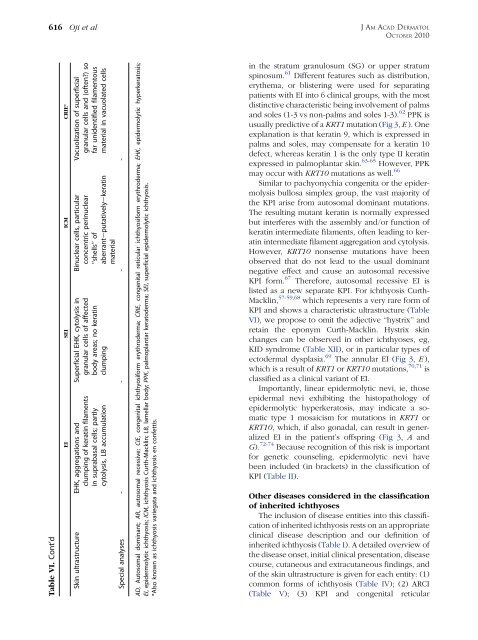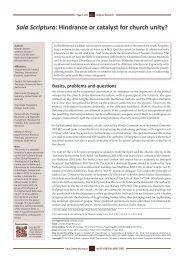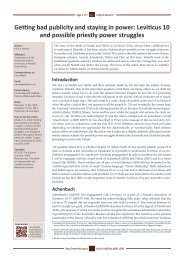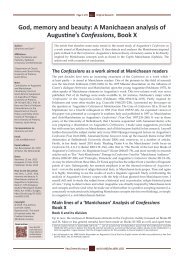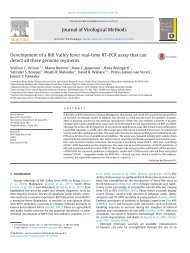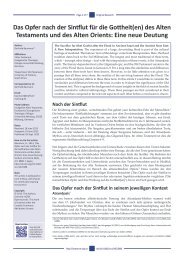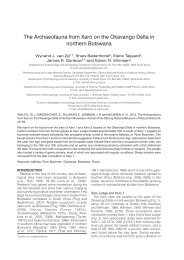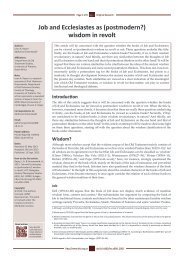Revised nomenclature and classification of inherited ichthyoses ...
Revised nomenclature and classification of inherited ichthyoses ...
Revised nomenclature and classification of inherited ichthyoses ...
Create successful ePaper yourself
Turn your PDF publications into a flip-book with our unique Google optimized e-Paper software.
616 Oji et al<br />
Table VI. Cont’d<br />
EI SEI ICM CRIE*<br />
Vacuolization <strong>of</strong> superficial<br />
granular cells <strong>and</strong> (<strong>of</strong>ten?) so<br />
far unidentified filamentous<br />
material in vacuolated cells<br />
Binuclear cells, particular<br />
concentric perinuclear<br />
‘‘shells’’ <strong>of</strong><br />
aberranteputativelyekeratin<br />
Superficial EHK, cytolysis in<br />
granular cells <strong>of</strong> affected<br />
body areas; no keratin<br />
clumping<br />
Skin ultrastructure EHK, aggregations <strong>and</strong><br />
clumping <strong>of</strong> keratin filaments<br />
in suprabasal cells; partly<br />
cytolysis, LB accumulation<br />
material<br />
Special analyses - - - -<br />
AD, Autosomal dominant; AR, autosomal recessive; CIE, congenital ichthyosiform erythroderma; CRIE, congenital reticular ichthyosiform erythroderma; EHK, epidermolytic hyperkeratosis;<br />
EI, epidermolytic ichthyosis; ICM, ichthyosis Curth-Macklin; LB, lamellar body; PPK, palmoplantar keratoderma; SEI, superficial epidermolytic ichthyosis.<br />
*Also known as ichthyosis variegata <strong>and</strong> ichthyosis en confettis.<br />
JAM ACAD DERMATOL<br />
OCTOBER 2010<br />
in the stratum granulosum (SG) or upper stratum<br />
spinosum. 61 Different features such as distribution,<br />
erythema, or blistering were used for separating<br />
patients with EI into 6 clinical groups, with the most<br />
distinctive characteristic being involvement <strong>of</strong> palms<br />
<strong>and</strong> soles (1-3 vs non-palms <strong>and</strong> soles 1-3). 62 PPK is<br />
usually predictive <strong>of</strong> a KRT1 mutation (Fig 3, E ). One<br />
explanation is that keratin 9, which is expressed in<br />
palms <strong>and</strong> soles, may compensate for a keratin 10<br />
defect, whereas keratin 1 is the only type II keratin<br />
expressed in palmoplantar skin. 63-65 However, PPK<br />
may occur with KRT10 mutations as well. 66<br />
Similar to pachyonychia congenita or the epidermolysis<br />
bullosa simplex group, the vast majority <strong>of</strong><br />
the KPI arise from autosomal dominant mutations.<br />
The resulting mutant keratin is normally expressed<br />
but interferes with the assembly <strong>and</strong>/or function <strong>of</strong><br />
keratin intermediate filaments, <strong>of</strong>ten leading to keratin<br />
intermediate filament aggregation <strong>and</strong> cytolysis.<br />
However, KRT10 nonsense mutations have been<br />
observed that do not lead to the usual dominant<br />
negative effect <strong>and</strong> cause an autosomal recessive<br />
KPI form. 67 Therefore, autosomal recessive EI is<br />
listed as a new separate KPI. For ichthyosis Curth-<br />
Macklin, 57-59,68 which represents a very rare form <strong>of</strong><br />
KPI <strong>and</strong> shows a characteristic ultrastructure (Table<br />
VI), we propose to omit the adjective ‘‘hystrix’’ <strong>and</strong><br />
retain the eponym Curth-Macklin. Hystrix skin<br />
changes can be observed in other <strong>ichthyoses</strong>, eg,<br />
KID syndrome (Table XII), or in particular types <strong>of</strong><br />
ectodermal dysplasia. 69 The annular EI (Fig 3, E ),<br />
which is a result <strong>of</strong> KRT1 or KRT10 mutations, 70,71 is<br />
classified as a clinical variant <strong>of</strong> EI.<br />
Importantly, linear epidermolytic nevi, ie, those<br />
epidermal nevi exhibiting the histopathology <strong>of</strong><br />
epidermolytic hyperkeratosis, may indicate a somatic<br />
type 1 mosaicism for mutations in KRT1 or<br />
KRT10, which, if also gonadal, can result in generalized<br />
EI in the patient’s <strong>of</strong>fspring (Fig 3, A <strong>and</strong><br />
G). 72-74 Because recognition <strong>of</strong> this risk is important<br />
for genetic counseling, epidermolytic nevi have<br />
been included (in brackets) in the <strong>classification</strong> <strong>of</strong><br />
KPI (Table II).<br />
Other diseases considered in the <strong>classification</strong><br />
<strong>of</strong> <strong>inherited</strong> <strong>ichthyoses</strong><br />
The inclusion <strong>of</strong> disease entities into this <strong>classification</strong><br />
<strong>of</strong> <strong>inherited</strong> ichthyosis rests on an appropriate<br />
clinical disease description <strong>and</strong> our definition <strong>of</strong><br />
<strong>inherited</strong> ichthyosis (Table I). A detailed overview <strong>of</strong><br />
the disease onset, initial clinical presentation, disease<br />
course, cutaneous <strong>and</strong> extracutaneous findings, <strong>and</strong><br />
<strong>of</strong> the skin ultrastructure is given for each entity: (1)<br />
common forms <strong>of</strong> ichthyosis (Table IV); (2) ARCI<br />
(Table V); (3) KPI <strong>and</strong> congenital reticular


